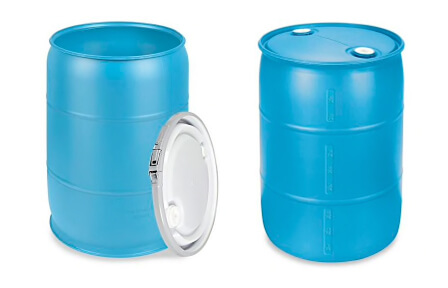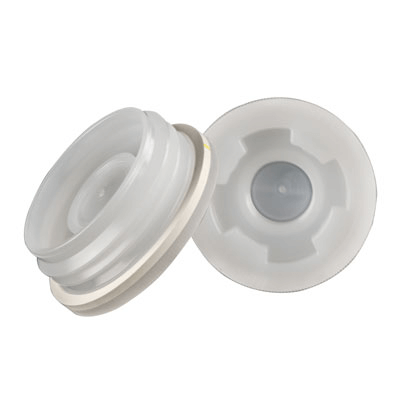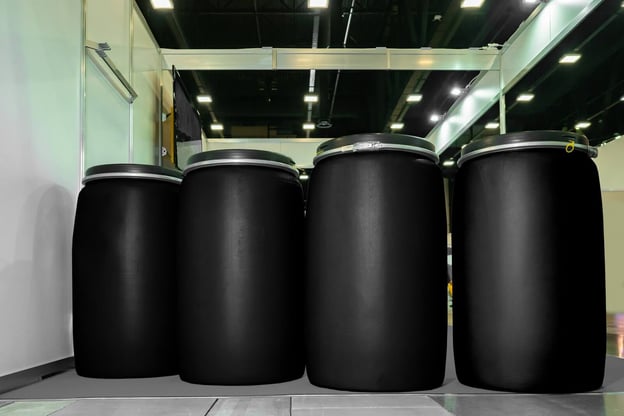Polyethylene drums, more commonly referred to as plastic drums, are industrial-grade containers made with high-density polyethylene (HDPE). They are lighter weight and are considered to be more cost effective than their steel drum counterparts. Plastic drums have widespread applications spanning both the residential and commercial sectors.
If you’re interested in using polyethylene drums for shipping chemicals and other manufactured materials, this guide will help you determine the right chemical packaging choice and answer some common questions about the polyethylene (HDPE) drum.
Why Choose a Polyethylene Drum?
Each year there are over 15 million plastic drums made in North America by four major producers. Note that when we refer to polyethylene drums in this article, we’re referring to drums, not pails, that can hold up to 55 gallons and a minimum of 15 gallons. These containers are used to store hazardous and non-hazardous liquid and sometimes powder products.
When choosing a proper drum, there are several reasons why one would opt for a polyethylene drum over any other option. Here are some of the decisions you must take into consideration when choosing adequate packaging.
Plastic vs. Steel
Plastic and steel are the two most common materials for storage drums. Plastic drums are lower weight, leading to decreased shipping costs. Most plastic drums that are used for industrial purposes are also made of HDPE (High-Density Polyethylene). HDPE is a specific type of plastic that is resistant to extremely high or low pH levels, making it a safe choice for many different types of materials - but not all.
For example, some solvents cannot be stored in plastic and require steel drums. Some hazardous materials are simply too dangerous to be shipping plastic drums. It’s up to you to determine which material will work best for storing your product.
UN Rating
As we’ve mentioned before in our packaging blog series, the United Nations (UN) is the governing body responsible for creating and distributing chemical shipping regulations worldwide. Any drum used to ship materials, especially hazardous materials, must comply with these regulations and clearly print an identifying UN packaging code on the drum. You can learn more about reading UN packaging codes at our blog here.
Linings & Gaskets
Steel drums can break down after coming in contact with caustic materials. To lower the cost and eliminate the inconvenience of having to place a plastic liner in a steel barrel, many manufacturers choose to use one barrel made with HDPE for shipping materials. That being said, some people still choose to use drum liners with polyethylene drums to protect the product from being contaminated and prevent any possible leaks in transit.
Some drums, especially open or closed head steel drums, also rely on gaskets to close securely and maintain UN compliance for shipping. Gaskets are used to close a drum tightly and, like liners, can prevent both contamination and leaks in transit. While it’s not unheard of plastic drums to use gaskets, they’re much more common in steel drum usage.
To summarize, polyethylene drums tend to be more all-purpose for shipping materials with varying pH levels and requirements. Steel drums provide more protection and are more often used when the material being shipped is hazardous or has a heavier bulk weight. For this remainder of this article, we will focus on polyethylene drums only.
Requirements for Shipping Hazardous Materials in Plastic Drums
As mentioned above, all UN rated packaging must be tested to receive a legal packaging code. This is especially important when shipping hazardous materials that could be potentially dangerous to anyone in contact with the shipment while in transit. Because plastic is generally not considered as strong as a steel drum, testing is extra important to ensure the container can last through the shipping process without spilling or releasing in transit.
Both international and domestic regulations dictates that the shipper must comply with the following requirements for shipping hazardous materials:
- The shipper must determine that, when closed, there is no discernible release of materials from the drum.
- There is no materials residue on the package exterior.
- The package must be rated for the material it contains and will not cause any reactions.
- Adequate spacing is left in liquid packaging to account for expansion with environmental changes.
Note that any packages, drums included, that are used to ship hazardous materials internationally automatically have a five-year life span from the date of manufacturing. Polyethylene drums more than five years old can be used domestically, but will be out of compliance if shipping overseas.
Types of Polyethylene Drum Heads
Plastic drums come in two varieties: open head and tight head. Open head, or open top without a lid, allows you to get your material in and out of the drum much easier. Only the bottom is seamed, so the top can be removed for easy access. These can be used for liquids, but are mostly used for dry products. Open head drums may also use a gasket for extra security.
Tight head, or closed head, plastic drums, on the other hand, are designed to stay shut tight. Both ends are seamed, leaving no easily removable lid. Instead, they are usually accessed through fittings on the top of the drum. Tight head polyethylene drums are mainly used for water and other liquid products. In the image below, the left drum is open head. The right drum is tight head.

Source: Greif Industial
Buttress Threading for Polyethylene (HDPE) Drums
If you plan to fill or extract liquids to and from closed head drums, you will need to know the type of bung, or top opening, the drum has. Without knowing the type of threading on your bung, you may try to use the wrong faucet hookup or plug.
Some people may find it difficult to determine what thread they have on their drums: buttress or NPT. The best way to distinguish between a NPT and buttress thread is by their appearances. Buttress threads are sometimes called “coarse threads” because they are spaced further apart, giving them a coarse appearance. Meanwhile, NPT threads are referred to as “fine threads” because they are spaced closely together.
The good news is that there are adaptors to convert buttress threads to NPT threads and vice versa available on the market. Once you determine which one you have, you can purchase adaptors as needed to switch up your threading.

Source: United States Plastic Corp
Polyethylene (HDPE) Drums FAQs
As a toll blender, we receive many questions from customers regarding the different aspects and characteristics of polyethylene (HDPE) drums in relation to a wide variety of chemicals. Here are some of the most common questions we see.
When should you use white or natural drums?
White and natural polyethylene drums are ideal for assessing the quantity of their contents and streamlining the reordering process for several compelling reasons. Their translucent or opaque design allows users to visually inspect the level of the stored material without the need for additional tools or opening the drum, providing a convenient and efficient way to monitor inventory levels. This transparency is especially valuable for businesses and industries where accurate inventory management is critical, as it helps prevent unexpected shortages or overstocking.
When should you use black drums?
Black polyethylene drums are the best for UV protection and are the only drums not required by law to have extra UV protection added to the resin. There are three grades of black; standard, food grade and conductive. For high purity UV sensitive, choose food grade black.

Why doesn’t everyone use black drums? It is a caution that black heats up a lot more than any other color—as much as 20℃ if outside in hotter states like Arizona, for example. If heat sensitivity is an issue, choose a white drum for UV protection and less heat generation.
Note that there are several other colored drums you can choose to use as well, but they tend to change colors overtime, which may impact your choice. For example, blues and greens can change hues with some ladings and red has a reputation as a color guaranteed to fade.
Should I get fluorinated polyethylene drums?
Fluorination is a process that exposes HDPE containers to fluorine atoms under controlled condition to improve the binding of the atoms in the plastic drum and decrease the chances of leakage or permeability. This matters because wall paneling and odor retention on plastic storage containers is a huge liability for your brand. Fluorination can prevent a loss of chemicals that could be a significant environmental hazard through the container walls.
How can I tell if my plastic drum is rated for food grade?
To identify food grade drums, flip the drum over and look for the recycling number on the bottom. If it is labeled 1, 2, 4 or 5 the drum is safe to store food in. There could also be a cup or fork symbol to indicate safe for food.
Should I buy used and reconditioned or new plastic drums?
Reconditioned drums are drums that have undergone the reconditioning process to ensure optimum repeat uses. It is more cost-effective than purchasing newly manufactured drums every time you need to make a shipment.
Used drums are still held to stringent material handling standards, especially by the UN’s guidelines, but they should not be used for food grade products. They tend to have widespread use in the industrial manufacturing and storage industries.
Remember, the filler or offeror for shipment is responsible for determining the suitability of packaging for its lading. Most manufacturers will offer guidance, but the final responsibility for the selection rests with the user. This leaves the risk with the user, as selecting the wrong type of drum can lead to cross contamination and leaks. This drum failure can lead to hefty fines and penalties for the filler.
Need some assistance? Royal Chemical has over 80 years of experience in packaging and shipping chemical materials, both hazardous and non-hazardous. If you’re interested in learning more about packaging options, schedule a free consultation here.

